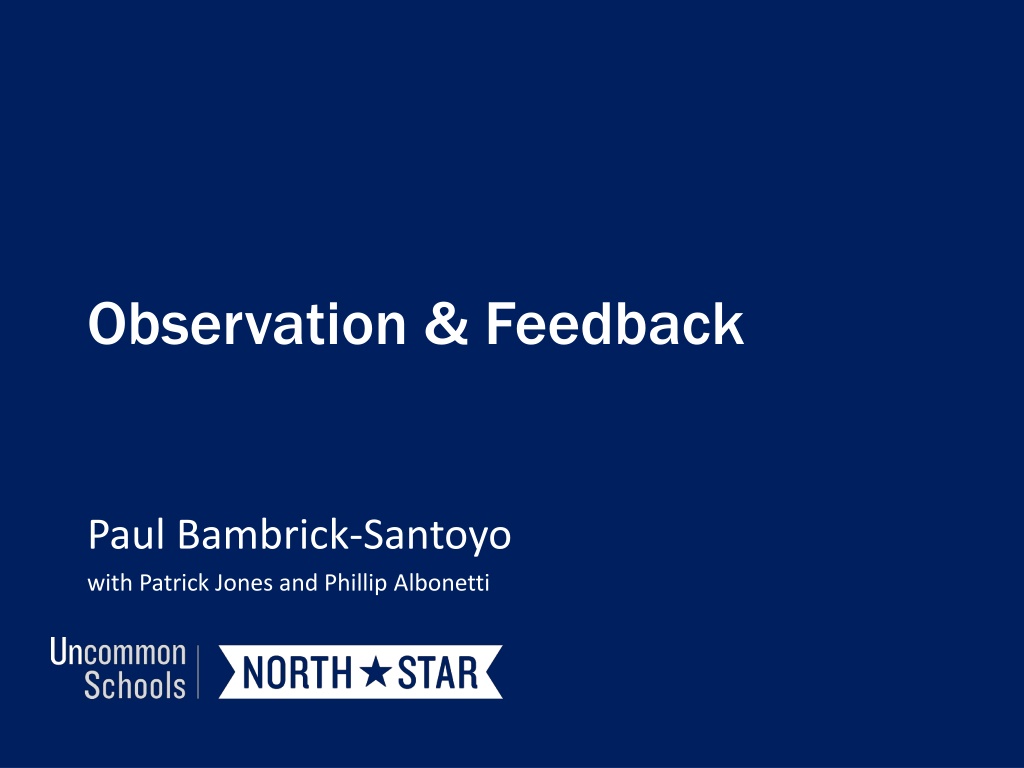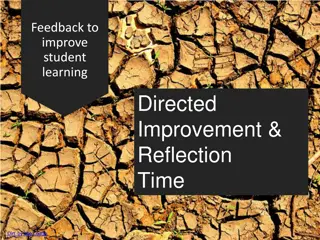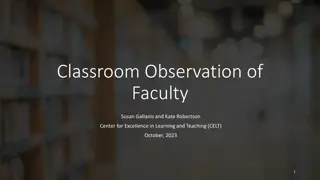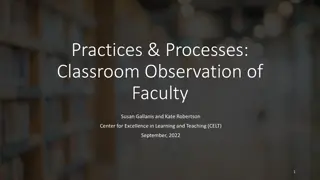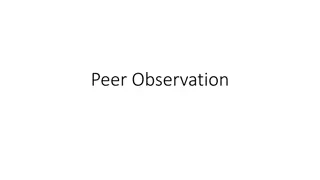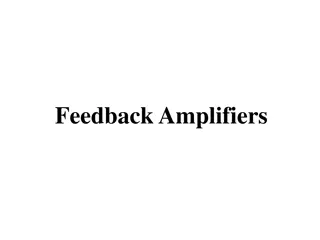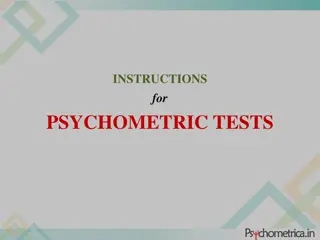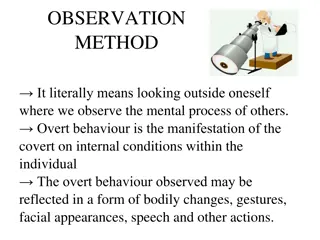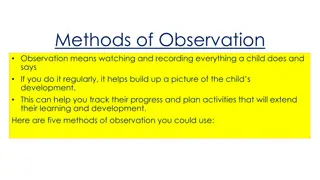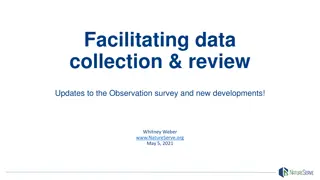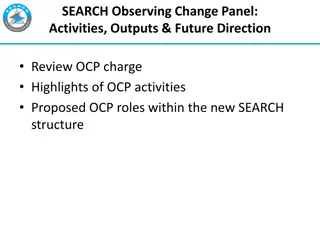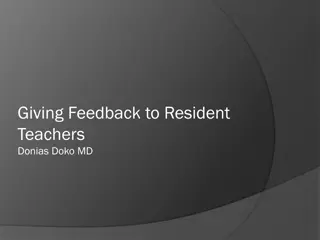Observation & Feedback in Educational Leadership
In the realm of educational leadership, the process of observation and feedback plays a crucial role in improving teaching practices and ultimately enhancing student learning outcomes. This involves coaching teachers, prioritizing teacher development, and utilizing time effectively to cultivate a culture of continuous improvement. Through data-driven instruction, planning, and professional development, school leaders can guide educators towards excellence. The Seven Levers of Leadership framework emphasizes the significance of consistent observation and feedback to support teacher growth and student achievement.
Download Presentation

Please find below an Image/Link to download the presentation.
The content on the website is provided AS IS for your information and personal use only. It may not be sold, licensed, or shared on other websites without obtaining consent from the author. Download presentation by click this link. If you encounter any issues during the download, it is possible that the publisher has removed the file from their server.
E N D
Presentation Transcript
Observation & Feedback Paul Bambrick-Santoyo with Patrick Jones and Phillip Albonetti
So there we were August of 2012 First year teacher with first year teacher issues Cursing, horseplay, and a pen top Meeting with the principal an AP within the first two weeks Any comparable stories? This July we will get dozens of new first year teachers who will have similar issues. Now what?
Opening Questions: Outside of growing on our own (simply through experience and self-reflection), what is the #1 thing that helps us get better as teachers or as school leaders? In the average school, how many times per year is a new teacher observed? How about an experienced teacher?
Big Idea: Exceptional school leaders succeed because of how they use their time, and their time prioritizes teacher development. Observation & Feedback is not to evaluate a teacher; but to find the most effective way to coach them to improve student learning.
Seven Levers of Leadership-- Instruction: Data-Driven Instruction: Define the roadmap for rigor and adapt teaching to meet students needs Observation & Feedback: Coach teachers to improve the learning Planning: Prevent problems and guarantee strong lessons Professional Development: Strengthen culture and instruction with hands-on training that sticks
Seven Levers of Leadership-- Instruction: Data-Driven Instruction: Define the roadmap for rigor and adapt teaching to meet students needs MONTHLY/ YEARLY Observation & Feedback: Coach teachers to improve the learning Planning: Prevent problems and guarantee strong lessons Professional Development: Strengthen culture and instruction with hands-on training that sticks
Seven Levers of Leadership-- Instruction: Data-Driven Instruction: Define the roadmap for rigor and adapt teaching to meet students needs Observation & Feedback: Coach teachers to improve the learning Planning: Prevent problems and guarantee strong lessons DAILY/ WEEKLY Professional Development: Strengthen culture and instruction with hands-on training that sticks
Goals for Todays Workshop: Increase our ability to identify the key action steps in classroom observations and give effective feedback Develop the tools for holding teachers accountable to continual development
Reflections--Observation & Feedback Think about the teachers who have been the easiest for you to manage and help them improve: Why was it easy to manage them? How did their personality, teaching challenges and responsiveness contribute to that ease? Think about the teachers who have been the hardest for you to manage: Why was it difficult to manage them? How did their personality, teaching challenges and (un)responsiveness contribute to that difficulty?
Profiles of Easy-to-Manage Teachers: Reflective Eager to Improve Data-Driven Seek Feedback Responsive (follows through) Mission-aligned Positive Emotionally Stable
Profiles of Challenging Teachers: Serious Classroom Management Issues Intimidation/Discomfort: Teachers we gravitate AWAY from: Fairly strong teachers how do I improve them? Teachers where we experience a personality clash Teachers with far more teaching experience Teachers who are icy cold when receiving feedback Unresponsiveness: Teachers who do not implement the feedback that we give them: incompetent or resistant Underminers: Teachers who question your decisions and undermine your decisions with others
Why Teacher Development is So Challenging A Case Study
Failure Case Study: What positive attempts did the principal make to manage this teacher effectively? What went wrong in the principal s attempts to manage this teacher?
Failure Case Study Go to a sheet of chart paper with a group of four and write down your answers to these questions: What did Dr. Starr do well in his attempt to guide Ms. Brewer? What could he have done to lead her more effectively? You will have 7 minutes and 19 seconds.
Practice Why does Albonetti carve such awful pumpkins? Takeaway: Practice is essential!
Agenda: Content Time Introduction The Four Keys to Observation & Feedback 10:00-10:40 am First Two Keys Regular Observation Identifying the Right Action Steps 10:40 12:00 noon Third and Fourth Key Effective Feedback Holding Teachers Accountable 1:00-5:00 pm
The Four Keys: Regular Observation The Right Action Steps Effective Feedback Accountability
The Four Keys: Regular Observation: Lock in frequent and regular observations Right Action Steps: Choose the best action steps for change in each classroom observation Effective Feedback: Give face-to-face feedback that practices the action step Accountability: Create systems to ensure feedback translates to practice
Regular Observation Building the Schedule of Instructional Leaders to Lock in Observations & Feedback
Rationale for the Importance of Teacher Meetings: Face-to-face feedback is the most effective way to generate teacher improvement Emails only work for teachers who are hungry
Building Your Schedule: Pre Pre- -Work: Work: Count the # of instructional leaders in the school Figure out the leader-to-core teacher ratio o Goal is to get to 15 to 1 or less for weekly observations Place the blank calendar front and center. Task 1: Task 1: Block out all the time where you will most likely be busy with non- negotiable responsibilities. o e.g. Morning supervision, morning meetings, CPR, Lunch duty, Dismissal o Write in pencil.
Building Your Schedule: Task 2: Task 2: List all of the teachers in your building. Divide the teachers between the school leaders who will observe staff. This list isn t final, so don t sweat it too much. Task 3: Task 3: Write into the schedule when you will meet with these teachers for observation and lesson plan feedback. Each meeting should take 30 minutes. Consider planning meetings in large blocks to finish them more quickly. See page 68 of Leverage Leadership or the example in your binder for an example.
Building Your Schedule: Task 4: Task 4: Map out the core times when you can go to observations Goal: observation time occurs before you will meet with the teacher each week Goal: 15 minutes per teacher you will observe Thus, one post-it (1 hr) represents 4 observations Consider planning observations in 1 hour blocks Task 5: Task 5: Type your tasks into your Outlook calendar for the week of August 12-16. [Bonus] Set the task as weekly occurrences that last until the end of September.
Evaluate Your Schedule: Trade your schedule with another leader s. Both of you evaluate the schedules by asking and answering these questions. Where might this schedule not work? Is there a change we could make to mitigate that?
Reflection: What about this schedule makes regular observation happen more consistently? What are the big takeaways for building my schedule and my leadership team s schedules? Write your takeaways on the Observation & Feedback Reflection page.
Big Idea: By receiving weekly observations and feedback, a teacher gets more coaching in one year as most receive in fifteen. 2 observations per year X 15 years = 30 opportunities for coaching 35+ observations per year X 1 year = 35+ opportunities for coaching
Rationale For Locked-in Teacher Meetings: Face-to-face feedback is the most effective way to generate teacher improvement emails only work for teachers who are hungry Don t waste time tracking down teachers to give feedback that will translate to not giving the feedback over time Use the meeting to incentivize yourself to get the observation done
Now What? We ve observed the teachers. Now what do we tell them?
Choosing the Right Action Step Effective vs. Ineffective Action Steps [Action Step = Key Lever]
Selecting the Right Action Steps: Criteria for selecting right action step: Is it directly connected to student learning? Does it address a root cause? Does the action positively change multiple areas? Is this change a necessary one to allow for further improvements to come after it? Is the recommendation the quickest and most effective way to make this change happen? Make it measurable, specific and targeted: If you can t make the change in a week, the action step isn t small enough Can you easily measure if the teachers has made the change?
Keys to Writing a Great Action Step: First Key What will teachers do when they implement this lever? Second Key What evidence will you have that teachers now know how to do this? Third Key Can they accomplish this objective in a week?
Converting Professional Development Goals to Bite-Sized Action Steps: Classroom management example Too High Increase on-task behavior during Opening Procedures Still Too High Improve Strong Voice Better Use Economy of Language during Opening Procedures Square Up & Stand Still during Opening Procedures
Converting Professional Development Goals to Bite-Sized Action Steps: Classroom rigor example Too High Improve your questioning Still Too High Ask higher-order, more rigorous questions Better Script out inference questions on character motive into the lesson plans
Precise Action Steps Your Turn
Converting Professional Development Goals to Bite-Sized Action Steps--Management: Too High Increase urgency Still Too High Improve pacing Better
Converting Professional Development Goals to Bite-Sized Action Steps--Rigor Too High Increase rigor Still Too High Improve rigor in the Do Now Better
Feedback on Effective Action Steps: Receive Feedback (5 min partner style!) Share the final action steps for each slide Give feedback to the objectives based on the key questions: o Is it specific: does it refer to something a teacher will be able to do when they walk out of the meeting? o Is it observable: Will you be able to easily evaluate if they accomplished the lever? o Is it bite-sized: can a teacher accomplish this in one week?
Reflection: What are your big takeaways for how to write quality action steps? Write your ideas on the Observation & Feedback Reflection.
Choosing the Right Action Steps Video Case Study #1
Case Study #1 https://www.youtube.com/watch?v=yEj8yTEbSdE Let s sit in the classroom for just a few minutes. As you watch, jot observations (whether positive or negative), on the post-it notes.
Case Study #1Debrief: Role: Select one person to be the recorder. He or she will write responses in the T-chart in the binder. Challenges: Identify all of the issues going on in this classroom: surface problems and root causes (5 min) Go in order around the circle: each person has 30 secs to identify one challenge (no one may comment!) If you don t have an idea, say Pass If you like an idea, when it s your turn simply say, I would like to add to that idea by Even if 4-5 people pass in a row, keep going for 10 min Recorder: Put responses in management or rigor
Case Study #1Debrief: Reflection:feasibility of each idea (5 min) 1 min silent individual reflection on the list: what are the highest leverage action steps you d recommend? Go in order around the circle once: each person has about 60 secs to share 1-2 recommended action steps If a person doesn t have a thought to share, say Pass and come back to that person later. Action Steps: choose top 2 key actions teacher should take (10 min): One in management, the other in content/rigor [See protocol on next page]
Protocol for Action Steps (10 min): Discuss & choose top 2 actions steps Write them as precisely as you can Criteria for selection of the 2 action steps: o Is the action step directly connected to student learning? o Does it address a root cause? o Does it positively change multiple areas? o Is it necessary to pave the way for other improvements? o Is it the most effective way to make change happen? o Make it measurable, specific and targeted: If you can t make the change in a week, the action step isn t small enough. Can you easily measure if the teachers has made the change?
Reflection: What are your big takeaways for how to write quality action steps? Write your ideas on the Observation & Feedback Reflection.
Big Ideas--The Link Between Data & Observation: Rigor is undefined until you determine how to assess it. Thus, without data on whether students are learning, you cannot adequately observe for rigor.
Giving Feedback Effectively What NOT to Do
What NOT to Do When Giving Feedback: Do all the talking Let teacher do all the talking on the wrong topic Fail to write anything down (teacher or principal) about what teacher should be doing
Giving Feedback Effectively A Master Clip
Effective FeedbackA Master Clip: Julie s Lever: Ask less scaffolded questions when a student gets the wrong answer to increase student thinking Watch Video (clip 3): Write down the key questions or comments that Julie makes while talking with Carly. What protocol does Julie use to lead this meeting with Carly? Name all of the steps she takes in your own words.
The Six Steps to Effective Feedback: 1. PRECISE PRAISE: narrative the positive 2. PROBE: State targeted open-ended question about the core issue 3. ID PROBLEM & ACTION STEP: Identify problem; state concrete action step that will address issue 4. PRACTICE: Role play/simulate how teacher could have improved current class 5. PLAN AHEAD: Design/revise upcoming lesson plan components to implement action 6. SET TIMELINE: Establish time by which to accomplish action step
